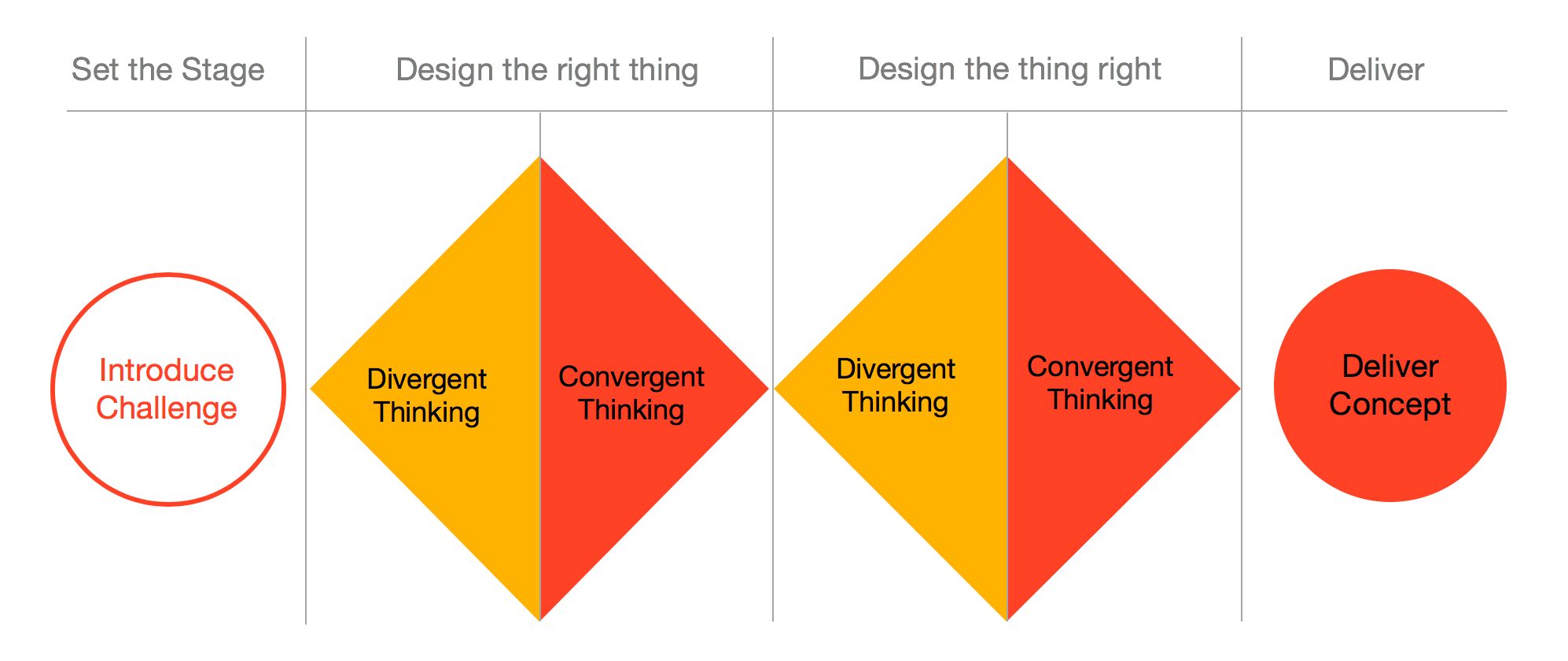The double diamond is a well-known visual map of the design process starting with the challenge at hand and ending with a final solution. The process pairs divergent thinking (where the participants come up with many ideas) with convergent thinking (narrowing the ideas down to the most feasible and practical).
– – –
The Double Diamond is a problem-solving framework that originally began in the design world. It describes four phases of problem solving:
- Set the stage
- Design the right thing
- Design the thing right
- Deliver
The first phase is when a problem is acknowledged, and the problem-solving challenge is introduced. Phase 2 and 3 are the active portions of the problem-solving process where the solution is ideated, designed, and created. In the last phase, the solution is delivered to the user.
The diamonds represent the different types of thinking that are needed during the problem-solving process. The left-hand side of each diamond represents Divergent Thinking. This is when teams are encouraged to widen their thinking and generate a broad range of ideas. On this side of the diamond, quantity is more important than quality. Divergent thinking benefits from diversity of thought, so be sure to include new and varied team members who can help everyone think outside of the box.
ITK Tip: Check out the 4 tools in the “Generate Ideas” category of our Toolkit: Lotus Blossom, Mind Mapping, TRIZ Prism, and Bodystorming!
After a certain threshold (based on time or some other factor), the team then moves into the right-hand side of the diamond. This area represents Convergent Thinking, where the team narrows their thinking. Here, they’ll focus on reducing, prioritizing, and eliminating many options into one. The team will often use evaluation criteria to help them remove options.
ITK Tip: Check out the 3 tools in the “Evaluation Options” category of our Toolkit: Rose, Bud, Thorn; Stormdraining; and Prototyping!
You’ll notice that there is a diamond in both Phase 2 and Phase 3. That’s because this cycle of divergent and convergent thinking is an iterative process. Although the diagram doesn’t explicitly show it, you can actually repeat the diamond pattern multiple times within one phase, whether in parallel or in series!
Another thing you’ll notice is the similarity of the labels in Phase 2 and Phase 3. However, they are critically different in meaning: In Phase 2, you design the right thing, whereas in Phase 3, you design the thing right.
The key distinction here is that Phase 2’s priority is to make sure you define the problem well. A clearly articulated problem statement ensures that all teammates are on the same page and that it’s a problem worth solving. If this phase is skipped, team may find themselves creating solutions for symptoms of a problem, rather than the real problem itself.
ITK Tip: Check out the Problem Framing canvas!
Once the team gains consensus on the problem, then the team embarks into Phase 3 where they can begin creating solutions. The team again flows from divergent to convergent thinking until they arrive at a final solution. Especially in Phase 3, it’s very common to have multiple iterations of this diamond cycle.
That’s the double diamond in a nutshell, and let us know in the comments below how your team uses this framework!

